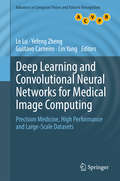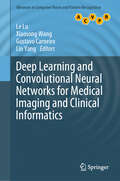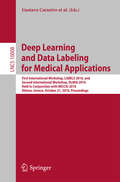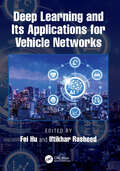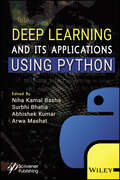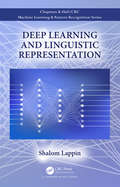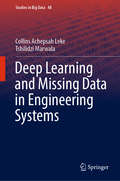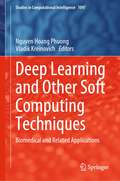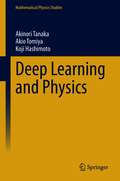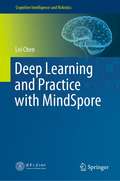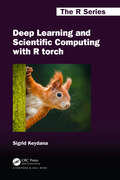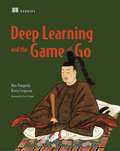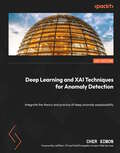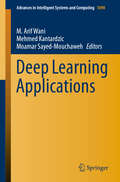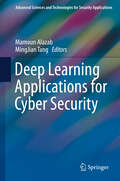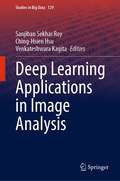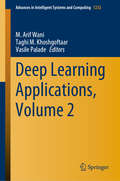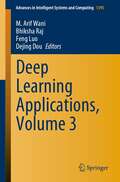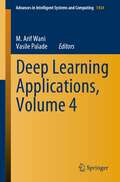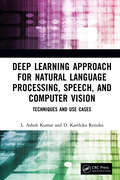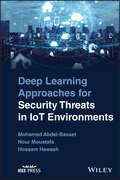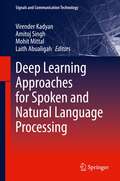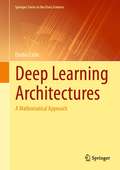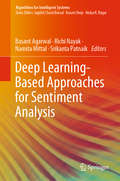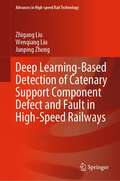- Table View
- List View
Deep Learning and Convolutional Neural Networks for Medical Image Computing
by Le Lu Yefeng Zheng Gustavo Carneiro Lin YangThis book presents a detailed review of the state of the art in deep learning approaches for semantic object detection and segmentation in medical image computing, and large-scale radiology database mining. A particular focus is placed on the application of convolutional neural networks, with the theory supported by practical examples. Features: highlights how the use of deep neural networks can address new questions and protocols, as well as improve upon existing challenges in medical image computing; discusses the insightful research experience of Dr. Ronald M. Summers; presents a comprehensive review of the latest research and literature; describes a range of different methods that make use of deep learning for object or landmark detection tasks in 2D and 3D medical imaging; examines a varied selection of techniques for semantic segmentation using deep learning principles in medical imaging; introduces a novel approach to interleaved text and image deep mining on a large-scale radiology image database.
Deep Learning and Convolutional Neural Networks for Medical Imaging and Clinical Informatics (Advances in Computer Vision and Pattern Recognition)
by Le Lu Xiaosong Wang Gustavo Carneiro Lin YangThis book reviews the state of the art in deep learning approaches to high-performance robust disease detection, robust and accurate organ segmentation in medical image computing (radiological and pathological imaging modalities), and the construction and mining of large-scale radiology databases. It particularly focuses on the application of convolutional neural networks, and on recurrent neural networks like LSTM, using numerous practical examples to complement the theory. The book’s chief features are as follows: It highlights how deep neural networks can be used to address new questions and protocols, and to tackle current challenges in medical image computing; presents a comprehensive review of the latest research and literature; and describes a range of different methods that employ deep learning for object or landmark detection tasks in 2D and 3D medical imaging. In addition, the book examines a broad selection of techniques for semantic segmentation using deep learning principles in medical imaging; introduces a novel approach to text and image deep embedding for a large-scale chest x-ray image database; and discusses how deep learning relational graphs can be used to organize a sizable collection of radiology findings from real clinical practice, allowing semantic similarity-based retrieval.The intended reader of this edited book is a professional engineer, scientist or a graduate student who is able to comprehend general concepts of image processing, computer vision and medical image analysis. They can apply computer science and mathematical principles into problem solving practices. It may be necessary to have a certain level of familiarity with a number of more advanced subjects: image formation and enhancement, image understanding, visual recognition in medical applications, statistical learning, deep neural networks, structured prediction and image segmentation.
Deep Learning and Data Labeling for Medical Applications
by Gustavo Carneiro Diana Mateus Loïc Peter Andrew Bradley João Manuel R. S. Tavares Vasileios Belagiannis João Paulo Papa Jacinto C. Nascimento Marco Loog Zhi Lu Jaime S. Cardoso Julien CornebiseThis book constitutes the refereed proceedings of two workshops held at the 19th International Conference on Medical Image Computing and Computer-Assisted Intervention, MICCAI 2016, in Athens, Greece, in October 2016: the First Workshop on Large-Scale Annotation of Biomedical Data and Expert Label Synthesis, LABELS 2016, and the Second International Workshop on Deep Learning in Medical Image Analysis, DLMIA 2016. The 28 revised regular papers presented in this book were carefully reviewed and selected from a total of 52 submissions. The 7 papers selected for LABELS deal with topics from the following fields: crowd-sourcing methods; active learning; transfer learning; semi-supervised learning; and modeling of label uncertainty. The 21 papers selected for DLMIA span a wide range of topics such as image description; medical imaging-based diagnosis; medical signal-based diagnosis; medical image reconstruction and model selection using deep learning techniques; meta-heuristic techniques for fine-tuning parameter in deep learning-based architectures; and applications based on deep learning techniques.
Deep Learning and Its Applications for Vehicle Networks
by Fei Hu Iftikhar RasheedDeep Learning (DL) is an effective approach for AI-based vehicular networks and can deliver a powerful set of tools for such vehicular network dynamics. In various domains of vehicular networks, DL can be used for learning-based channel estimation, traffic flow prediction, vehicle trajectory prediction, location-prediction-based scheduling and routing, intelligent network congestion control mechanism, smart load balancing and vertical handoff control, intelligent network security strategies, virtual smart and efficient resource allocation and intelligent distributed resource allocation methods. This book is based on the work from world-famous experts on the application of DL for vehicle networks. It consists of the following five parts: (I) DL for vehicle safety and security: This part covers the use of DL algorithms for vehicle safety or security. (II) DL for effective vehicle communications: Vehicle networks consist of vehicle-to-vehicle and vehicle-to-roadside communications. This part covers how Intelligent vehicle networks require a flexible selection of the best path across all vehicles, adaptive sending rate control based on bandwidth availability and timely data downloads from a roadside base-station. (III) DL for vehicle control: The myriad operations that require intelligent control for each individual vehicle are discussed in this part. This also includes emission control, which is based on the road traffic situation, the charging pile load is predicted through DL andvehicle speed adjustments based on the camera-captured image analysis. (IV) DL for information management: This part covers some intelligent information collection and understanding. We can use DL for energy-saving vehicle trajectory control based on the road traffic situation and given destination information; we can also natural language processing based on DL algorithm for automatic internet of things (IoT) search during driving. (V) Other applications. This part introduces the use of DL models for other vehicle controls. Autonomous vehicles are becoming more and more popular in society. The DL and its variants will play greater roles in cognitive vehicle communications and control. Other machine learning models such as deep reinforcement learning will also facilitate intelligent vehicle behavior understanding and adjustment. This book will become a valuable reference to your understanding of this critical field.
Deep Learning and its Applications using Python
by Niha Kamal Basha Surbhi Bhatia Khan Abhishek KumarArwa MashatThis book thoroughly explains deep learning models and how to use Python programming to implement them in applications such as NLP, face detection, face recognition, face analysis, and virtual assistance (chatbot, machine translation, etc.). It provides hands-on guidance in using Python for implementing deep learning application models. It also identifies future research directions for deep learning.
Deep Learning and Linguistic Representation (Chapman And Hall/crc Machine Learning And Pattern Recognition Ser.)
by Shalom LappinThe application of deep learning methods to problems in natural language processing has generated significant progress across a wide range of natural language processing tasks. For some of these applications, deep learning models now approach or surpass human performance. While the success of this approach has transformed the engineering methods of machine learning in artificial intelligence, the significance of these achievements for the modelling of human learning and representation remains unclear. Deep Learning and Linguistic Representation looks at the application of a variety of deep learning systems to several cognitively interesting NLP tasks. It also considers the extent to which this work illuminates our understanding of the way in which humans acquire and represent linguistic knowledge. Key Features: combines an introduction to deep learning in AI and NLP with current research on Deep Neural Networks in computational linguistics. is self-contained and suitable for teaching in computer science, AI, and cognitive science courses; it does not assume extensive technical training in these areas. provides a compact guide to work on state of the art systems that are producing a revolution across a range of difficult natural language tasks.
Deep Learning and Missing Data in Engineering Systems: Applications To Engineering Systems (Studies in Big Data #48)
by Collins Achepsah Leke Tshilidzi MarwalaDeep Learning and Missing Data in Engineering Systems uses deep learning and swarm intelligence methods to cover missing data estimation in engineering systems. The missing data estimation processes proposed in the book can be applied in image recognition and reconstruction. To facilitate the imputation of missing data, several artificial intelligence approaches are presented, including:deep autoencoder neural networks;deep denoising autoencoder networks;the bat algorithm;the cuckoo search algorithm; andthe firefly algorithm. The hybrid models proposed are used to estimate the missing data in high-dimensional data settings more accurately. Swarm intelligence algorithms are applied to address critical questions such as model selection and model parameter estimation. The authors address feature extraction for the purpose of reconstructing the input data from reduced dimensions by the use of deep autoencoder neural networks. They illustrate new models diagrammatically, report their findings in tables, so as to put their methods on a sound statistical basis. The methods proposed speed up the process of data estimation while preserving known features of the data matrix. This book is a valuable source of information for researchers and practitioners in data science. Advanced undergraduate and postgraduate students studying topics in computational intelligence and big data, can also use the book as a reference for identifying and introducing new research thrusts in missing data estimation.
Deep Learning and Other Soft Computing Techniques: Biomedical and Related Applications (Studies in Computational Intelligence #1097)
by Nguyen Hoang Phuong Vladik KreinovichThis book focuses on the use of artificial intelligence (AI) and computational intelligence (CI) in medical and related applications. Applications include all aspects of medicine: from diagnostics (including analysis of medical images and medical data) to therapeutics (including drug design and radiotherapy) to epidemic- and pandemic-related public health policies.Corresponding techniques include machine learning (especially deep learning), techniques for processing expert knowledge (e.g., fuzzy techniques), and advanced techniques of applied mathematics (such as innovative probabilistic and graph-based techniques).The book also shows that these techniques can be used in many other applications areas, such as finance, transportation, physics. This book helps practitioners and researchers to learn more about AI and CI methods and their biomedical (and related) applications—and to further develop this important research direction.
Deep Learning and Physics (Mathematical Physics Studies)
by Akinori Tanaka Akio Tomiya Koji HashimotoWhat is deep learning for those who study physics? Is it completely different from physics? Or is it similar? In recent years, machine learning, including deep learning, has begun to be used in various physics studies. Why is that? Is knowing physics useful in machine learning? Conversely, is knowing machine learning useful in physics? This book is devoted to answers of these questions. Starting with basic ideas of physics, neural networks are derived naturally. And you can learn the concepts of deep learning through the words of physics.In fact, the foundation of machine learning can be attributed to physical concepts. Hamiltonians that determine physical systems characterize various machine learning structures. Statistical physics given by Hamiltonians defines machine learning by neural networks. Furthermore, solving inverse problems in physics through machine learning and generalization essentially provides progress and even revolutions in physics. For these reasons, in recent years interdisciplinary research in machine learning and physics has been expanding dramatically. This book is written for anyone who wants to learn, understand, and apply the relationship between deep learning/machine learning and physics. All that is needed to read this book are the basic concepts in physics: energy and Hamiltonians. The concepts of statistical mechanics and the bracket notation of quantum mechanics, which are explained in columns, are used to explain deep learning frameworks.We encourage you to explore this new active field of machine learning and physics, with this book as a map of the continent to be explored.
Deep Learning and Practice with MindSpore (Cognitive Intelligence and Robotics)
by Lei ChenThis book systematically introduces readers to the theory of deep learning and explores its practical applications based on the MindSpore AI computing framework. Divided into 14 chapters, the book covers deep learning, deep neural networks (DNNs), convolutional neural networks (CNNs), recurrent neural networks (RNNs), unsupervised learning, deep reinforcement learning, automated machine learning, device-cloud collaboration, deep learning visualization, and data preparation for deep learning. To help clarify the complex topics discussed, this book includes numerous examples and links to online resources.
Deep Learning and Scientific Computing with R torch (Chapman & Hall/CRC The R Series)
by Sigrid Keydanatorch is an R port of PyTorch, one of the two most-employed deep learning frameworks in industry and research. It is also an excellent tool to use in scientific computations. It is written entirely in R and C/C++. Though still "young" as a project, R torch already has a vibrant community of users and developers. Experience shows that torch users come from a broad range of different backgrounds. This book aims to be useful to (almost) everyone. Globally speaking, its purposes are threefold: - Provide a thorough introduction to torch basics – both by carefully explaining underlying concepts and ideas, and showing enough examples for the reader to become "fluent" in torch. - Again with a focus on conceptual explanation, show how to use torch in deep-learning applications, ranging from image recognition over time series prediction to audio classification. - Provide a concepts-first, reader-friendly introduction to selected scientific-computation topics (namely, matrix computations, the Discrete Fourier Transform, and wavelets), all accompanied by torch code you can play with. Deep Learning and Scientific Computing with R torch is written with first-hand technical expertise and in an engaging, fun-to-read way.
Deep Learning and the Game of Go
by Kevin Ferguson Max PumperlaSummaryDeep Learning and the Game of Go teaches you how to apply the power of deep learning to complex reasoning tasks by building a Go-playing AI. After exposing you to the foundations of machine and deep learning, you'll use Python to build a bot and then teach it the rules of the game.Foreword by Thore Graepel, DeepMindPurchase of the print book includes a free eBook in PDF, Kindle, and ePub formats from Manning Publications.About the TechnologyThe ancient strategy game of Go is an incredible case study for AI. In 2016, a deep learning-based system shocked the Go world by defeating a world champion. Shortly after that, the upgraded AlphaGo Zero crushed the original bot by using deep reinforcement learning to master the game. Now, you can learn those same deep learning techniques by building your own Go bot!About the BookDeep Learning and the Game of Go introduces deep learning by teaching you to build a Go-winning bot. As you progress, you'll apply increasingly complex training techniques and strategies using the Python deep learning library Keras. You'll enjoy watching your bot master the game of Go, and along the way, you'll discover how to apply your new deep learning skills to a wide range of other scenarios!What's insideBuild and teach a self-improving game AIEnhance classical game AI systems with deep learningImplement neural networks for deep learningAbout the ReaderAll you need are basic Python skills and high school-level math. No deep learning experience required.About the AuthorMax Pumperla and Kevin Ferguson are experienced deep learning specialists skilled in distributed systems and data science. Together, Max and Kevin built the open source bot BetaGo.Table of ContentsPART 1 - FOUNDATIONSToward deep learning: a machine-learning introductionGo as a machine-learning problemImplementing your first Go botPART 2 - MACHINE LEARNING AND GAME AIPlaying games with tree searchGetting started with neural networksDesigning a neural network for Go dataLearning from data: a deep-learning botDeploying bots in the wildLearning by practice: reinforcement learningReinforcement learning with policy gradientsReinforcement learning with value methodsReinforcement learning with actor-critic methodsPART 3 - GREATER THAN THE SUM OF ITS PARTSAlphaGo: Bringing it all togetherAlphaGo Zero: Integrating tree search with reinforcement learning
Deep Learning and XAI Techniques for Anomaly Detection: Integrate the theory and practice of deep anomaly explainability
by Cher Simon Jeff BarrCreate interpretable AI models for transparent and explainable anomaly detection with this hands-on guidePurchase of the print or Kindle book includes a free PDF eBookKey FeaturesBuild auditable XAI models for replicability and regulatory complianceDerive critical insights from transparent anomaly detection modelsStrike the right balance between model accuracy and interpretabilityBook DescriptionDespite promising advances, the opaque nature of deep learning models makes it difficult to interpret them, which is a drawback in terms of their practical deployment and regulatory compliance.Deep Learning and XAI Techniques for Anomaly Detection shows you state-of-the-art methods that'll help you to understand and address these challenges. By leveraging the Explainable AI (XAI) and deep learning techniques described in this book, you'll discover how to successfully extract business-critical insights while ensuring fair and ethical analysis.This practical guide will provide you with tools and best practices to achieve transparency and interpretability with deep learning models, ultimately establishing trust in your anomaly detection applications. Throughout the chapters, you'll get equipped with XAI and anomaly detection knowledge that'll enable you to embark on a series of real-world projects. Whether you are building computer vision, natural language processing, or time series models, you'll learn how to quantify and assess their explainability.By the end of this deep learning book, you'll be able to build a variety of deep learning XAI models and perform validation to assess their explainability.What you will learnExplore deep learning frameworks for anomaly detectionMitigate bias to ensure unbiased and ethical analysisIncrease your privacy and regulatory compliance awarenessBuild deep learning anomaly detectors in several domainsCompare intrinsic and post hoc explainability methodsExamine backpropagation and perturbation methodsConduct model-agnostic and model-specific explainability techniquesEvaluate the explainability of your deep learning modelsWho this book is forThis book is for anyone who aspires to explore explainable deep learning anomaly detection, tenured data scientists or ML practitioners looking for Explainable AI (XAI) best practices, or business leaders looking to make decisions on trade-off between performance and interpretability of anomaly detection applications. A basic understanding of deep learning and anomaly detection–related topics using Python is recommended to get the most out of this book.
Deep Learning Applications (Advances in Intelligent Systems and Computing #1098)
by Moamar Sayed-Mouchaweh Mehmed Kantardzic M. Arif WaniThis book presents a compilation of selected papers from the 17th IEEE International Conference on Machine Learning and Applications (IEEE ICMLA 2018), focusing on use of deep learning technology in application like game playing, medical applications, video analytics, regression/classification, object detection/recognition and robotic control in industrial environments. It highlights novel ways of using deep neural networks to solve real-world problems, and also offers insights into deep learning architectures and algorithms, making it an essential reference guide for academic researchers, professionals, software engineers in industry, and innovative product developers.
Deep Learning Applications for Cyber Security (Advanced Sciences and Technologies for Security Applications)
by Mamoun Alazab MingJian TangCybercrime remains a growing challenge in terms of security and privacy practices. Working together, deep learning and cyber security experts have recently made significant advances in the fields of intrusion detection, malicious code analysis and forensic identification. This book addresses questions of how deep learning methods can be used to advance cyber security objectives, including detection, modeling, monitoring and analysis of as well as defense against various threats to sensitive data and security systems. Filling an important gap between deep learning and cyber security communities, it discusses topics covering a wide range of modern and practical deep learning techniques, frameworks and development tools to enable readers to engage with the cutting-edge research across various aspects of cyber security. The book focuses on mature and proven techniques, and provides ample examples to help readers grasp the key points.
Deep Learning Applications in Image Analysis (Studies in Big Data #129)
by Sanjiban Sekhar Roy Ching-Hsien Hsu Venkateshwara KagitaThis book provides state-of-the-art coverage of deep learning applications in image analysis. The book demonstrates various deep learning algorithms that can offer practical solutions for various image-related problems; also how these algorithms are used by scientists and scholars in industry and academia. This includes autoencoder and deep convolutional generative adversarial network in improving classification performance of Bangla handwritten characters, dealing with deep learning-based approaches using feature selection methods for automatic diagnosis of covid-19 disease from x-ray images, imbalance image data sets of classification, image captioning using deep transfer learning, developing a vehicle over speed detection system, creating an intelligent system for video-based proximity analysis, building a melanoma cancer detection system using deep learning, plant diseases classification using AlexNet, dealing with hyperspectral images using deep learning, chest x-ray image classification of pneumonia disease using efficient net and inceptionv3.The book also addresses the difficulty of implementing deep learning in terms of computation time and the complexity of reasoning and modelling different types of data where information is currently encoded. Each chapter has the application of various new or existing deep learning models such as Deep Neural Network (DNN) and Deep Convolutional Neural Networks (DCNN). The detailed utilization of deep learning packages that are available in MATLAB, Python and R programming environments have also been discussed, therefore, the readers will get to know about the practical implementation of deep learning as well. The content of this book is presented in a simple and lucid style for professionals, nonprofessionals, scientists, and students interested in the research area of deep learning applications in image analysis.
Deep Learning Applications, Volume 2 (Advances in Intelligent Systems and Computing #1232)
by M. Arif Wani Taghi M. Khoshgoftaar Vasile PaladeThis book presents selected papers from the 18th IEEE International Conference on Machine Learning and Applications (IEEE ICMLA 2019). It focuses on deep learning networks and their application in domains such as healthcare, security and threat detection, fault diagnosis and accident analysis, and robotic control in industrial environments, and highlights novel ways of using deep neural networks to solve real-world problems. Also offering insights into deep learning architectures and algorithms, it is an essential reference guide for academic researchers, professionals, software engineers in industry, and innovative product developers.
Deep Learning Applications, Volume 3 (Advances in Intelligent Systems and Computing #1395)
by M. Arif Wani Bhiksha Raj Feng Luo Dejing DouThis book presents a compilation of extended version of selected papers from the 19th IEEE International Conference on Machine Learning and Applications (IEEE ICMLA 2020) and focuses on deep learning networks in applications such as pneumonia detection in chest X-ray images, object detection and classification, RGB and depth image fusion, NLP tasks, dimensionality estimation, time series forecasting, building electric power grid for controllable energy resources, guiding charities in maximizing donations, and robotic control in industrial environments. Novel ways of using convolutional neural networks, recurrent neural network, autoencoder, deep evidential active learning, deep rapid class augmentation techniques, BERT models, multi-task learning networks, model compression and acceleration techniques, and conditional Feature Augmented and Transformed GAN (cFAT-GAN) for the above applications are covered in this book. Readers will find insights to help them realize novel ways of using deep learning architectures and algorithms in real-world applications and contexts, making the book an essential reference guide for academic researchers, professionals, software engineers in the industry, and innovative product developers.
Deep Learning Applications, Volume 4 (Advances in Intelligent Systems and Computing #1434)
by M. Arif Wani Vasile PaladeThis book presents a compilation of extended versions of selected papers from 20th IEEE International Conference on Machine Learning and Applications (IEEE ICMLA 2021). It focuses on deep learning networks and their applications in domains such as healthcare, security and threat detection, fault diagnosis and accident analysis, and robotic control in industrial environments. It highlights novel ways of using deep neural networks to solve real-world problems, and also offers insights into deep learning architectures and algorithms, making it an essential reference guide for academic researchers, professionals, software engineers in industry, and innovative product developers. The book is fourth in the series published since 2017.
Deep Learning Approach for Natural Language Processing, Speech, and Computer Vision: Techniques and Use Cases
by L. Ashok Kumar D. Karthika RenukaDeep Learning Approach for Natural Language Processing, Speech, and Computer Vision provides an overview of general deep learning methodology and its applications of natural language processing (NLP), speech, and computer vision tasks. It simplifies and presents the concepts of deep learning in a comprehensive manner, with suitable, full-fledged examples of deep learning models, with an aim to bridge the gap between the theoretical and the applications using case studies with code, experiments, and supporting analysis. Features: Covers latest developments in deep learning techniques as applied to audio analysis, computer vision, and natural language processing. Introduces contemporary applications of deep learning techniques as applied to audio, textual, and visual processing. Discovers deep learning frameworks and libraries for NLP, speech, and computer vision in Python. Gives insights into using the tools and libraries in Python for real-world applications. Provides easily accessible tutorials and real-world case studies with code to provide hands-on experience. This book is aimed at researchers and graduate students in computer engineering, image, speech, and text processing.
Deep Learning Approaches for Security Threats in IoT Environments
by Mohamed Abdel-Basset Nour Moustafa Hossam HawashDeep Learning Approaches for Security Threats in IoT Environments An expert discussion of the application of deep learning methods in the IoT security environment In Deep Learning Approaches for Security Threats in IoT Environments, a team of distinguished cybersecurity educators deliver an insightful and robust exploration of how to approach and measure the security of Internet-of-Things (IoT) systems and networks. In this book, readers will examine critical concepts in artificial intelligence (AI) and IoT, and apply effective strategies to help secure and protect IoT networks. The authors discuss supervised, semi-supervised, and unsupervised deep learning techniques, as well as reinforcement and federated learning methods for privacy preservation. This book applies deep learning approaches to IoT networks and solves the security problems that professionals frequently encounter when working in the field of IoT, as well as providing ways in which smart devices can solve cybersecurity issues. Readers will also get access to a companion website with PowerPoint presentations, links to supporting videos, and additional resources. They’ll also find: A thorough introduction to artificial intelligence and the Internet of Things, including key concepts like deep learning, security, and privacy Comprehensive discussions of the architectures, protocols, and standards that form the foundation of deep learning for securing modern IoT systems and networks In-depth examinations of the architectural design of cloud, fog, and edge computing networks Fulsome presentations of the security requirements, threats, and countermeasures relevant to IoT networks Perfect for professionals working in the AI, cybersecurity, and IoT industries, Deep Learning Approaches for Security Threats in IoT Environments will also earn a place in the libraries of undergraduate and graduate students studying deep learning, cybersecurity, privacy preservation, and the security of IoT networks.
Deep Learning Approaches for Spoken and Natural Language Processing (Signals and Communication Technology)
by Virender Kadyan Amitoj Singh Mohit Mittal Laith AbualigahThis book provides insights into how deep learning techniques impact language and speech processing applications. The authors discuss the promise, limits and the new challenges in deep learning. The book covers the major differences between the various applications of deep learning and the classical machine learning techniques. The main objective of the book is to present a comprehensive survey of the major applications and research oriented articles based on deep learning techniques that are focused on natural language and speech signal processing. The book is relevant to academicians, research scholars, industrial experts, scientists and post graduate students working in the field of speech signal and natural language processing and would like to add deep learning to enhance capabilities of their work.Discusses current research challenges and future perspective about how deep learning techniques can be applied to improve NLP and speech processing applications;Presents and escalates the research trends and future direction of language and speech processing;Includes theoretical research, experimental results, and applications of deep learning.
Deep Learning Architectures: A Mathematical Approach (Springer Series in the Data Sciences)
by Ovidiu CalinThis book describes how neural networks operate from the mathematical point of view. As a result, neural networks can be interpreted both as function universal approximators and information processors. The book bridges the gap between ideas and concepts of neural networks, which are used nowadays at an intuitive level, and the precise modern mathematical language, presenting the best practices of the former and enjoying the robustness and elegance of the latter.This book can be used in a graduate course in deep learning, with the first few parts being accessible to senior undergraduates. In addition, the book will be of wide interest to machine learning researchers who are interested in a theoretical understanding of the subject.
Deep Learning-Based Approaches for Sentiment Analysis (Algorithms for Intelligent Systems)
by Basant Agarwal Namita Mittal Srikanta Patnaik Richi NayakThis book covers deep-learning-based approaches for sentiment analysis, a relatively new, but fast-growing research area, which has significantly changed in the past few years. The book presents a collection of state-of-the-art approaches, focusing on the best-performing, cutting-edge solutions for the most common and difficult challenges faced in sentiment analysis research. Providing detailed explanations of the methodologies, the book is a valuable resource for researchers as well as newcomers to the field.
Deep Learning-Based Detection of Catenary Support Component Defect and Fault in High-Speed Railways (Advances in High-speed Rail Technology)
by Zhigang Liu Wenqiang Liu Junping ZhongThis book focuses on the deep learning technologies and their applications in the catenary detection of high-speed railways. As the only source of power for high-speed trains, the catenary's service performance directly affects the safe operation of high-speed railways. This book systematically shows the latest research results of catenary detection in high-speed railways, especially the detection of catenary support component defect and fault. Some methods or algorithms have been adopted in practical engineering. These methods or algorithms provide important references and help the researcher, scholar, and engineer on pantograph and catenary technology in high-speed railways. Unlike traditional detection methods of catenary support component based on image processing, some advanced methods in the deep learning field, including convolutional neural network, reinforcement learning, generative adversarial network, etc., are adopted and improved in this book. The main contents include the overview of catenary detection of electrified railways, the introduction of some advance of deep learning theories, catenary support components and their characteristics in high-speed railways, the image reprocessing of catenary support components, the positioning of catenary support components, the detection of defect and fault, the detection based on 3D point cloud, etc.
